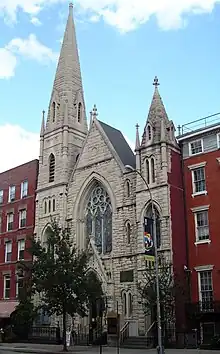Samuel Burrage Reed | |
|---|---|
 | |
| Born | January 7, 1834[1] |
| Nationality | American |
| Other names | S. B. Reed |
| Known for | Architect |
Samuel Burrage Reed was an American architect of Corona, New York, and Woodcliff Lake, New Jersey. He was active in mid-to-late nineteenth-century and early twentieth-century America, particularly in New York State, New York City, and Connecticut.
Born in Meriden, Connecticut, he was first trained as a carpenter before becoming an architect. He is notable for designing several mansions, as well as public and ecclesiastical buildings.[1] Reed was a member of the American Institute of Architects (AIA).
Works
- 1903 – Passaic County Court House, Paterson, New Jersey.[2]
- 1891 – New Middle Collegiate Church, Second Avenue, New York City.[3]: 196
- 1890 – Chester Wickwire House, Cortland, New York (now the 1890 House Museum).[1]
- 1889 - First Presbyterian Church Complex (Cortland, New York)[1]
- 1888 – James Bailey House, Manhattan, New York City (of Barnum & Bailey Circus fame).[1][3]: 516
- 1883 – John C. Reichert House, Tipton, Iowa.[1]
- Pinard Cottages, Newport, Rhode Island.[1]
References
Notes
- 1 2 3 4 5 6 7 8 C. Boggs, GenInfo
- ↑ "Passaic County Court House and Annex". New Jersey Historic Trust. Retrieved 2014-10-10.
- 1 2 White, Norval; Willensky, Elliot; Leadon, Fran (2010). AIA Guide to New York City (5th ed.). New York: Oxford University Press. ISBN 978-0-19538-386-7.
External links
 Media related to Samuel B. Reed at Wikimedia Commons
Media related to Samuel B. Reed at Wikimedia Commons
This article is issued from Wikipedia. The text is licensed under Creative Commons - Attribution - Sharealike. Additional terms may apply for the media files.